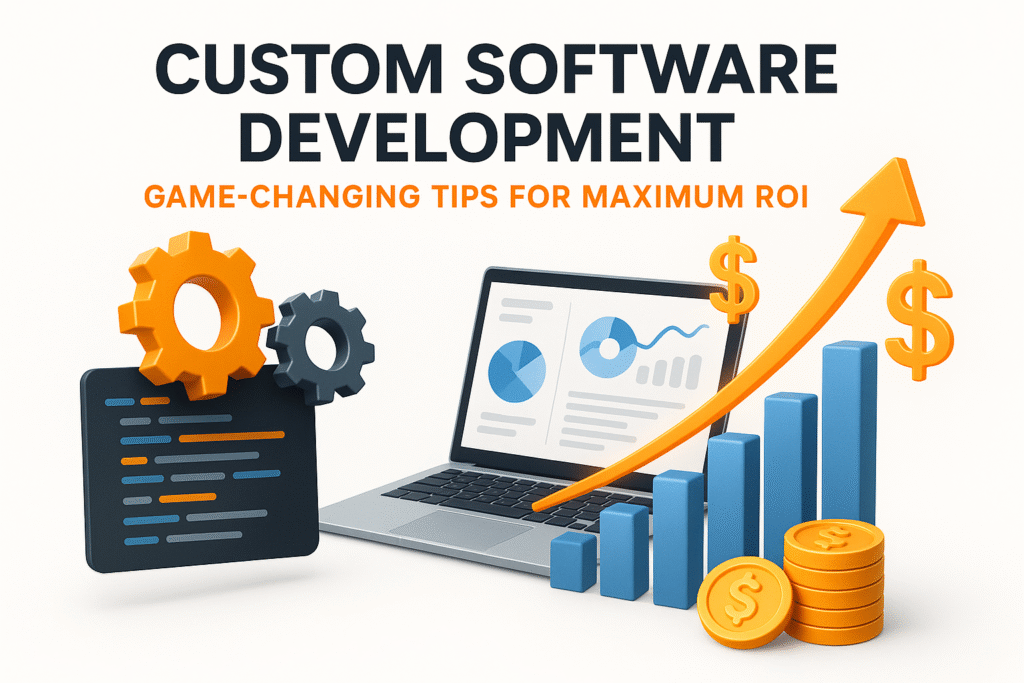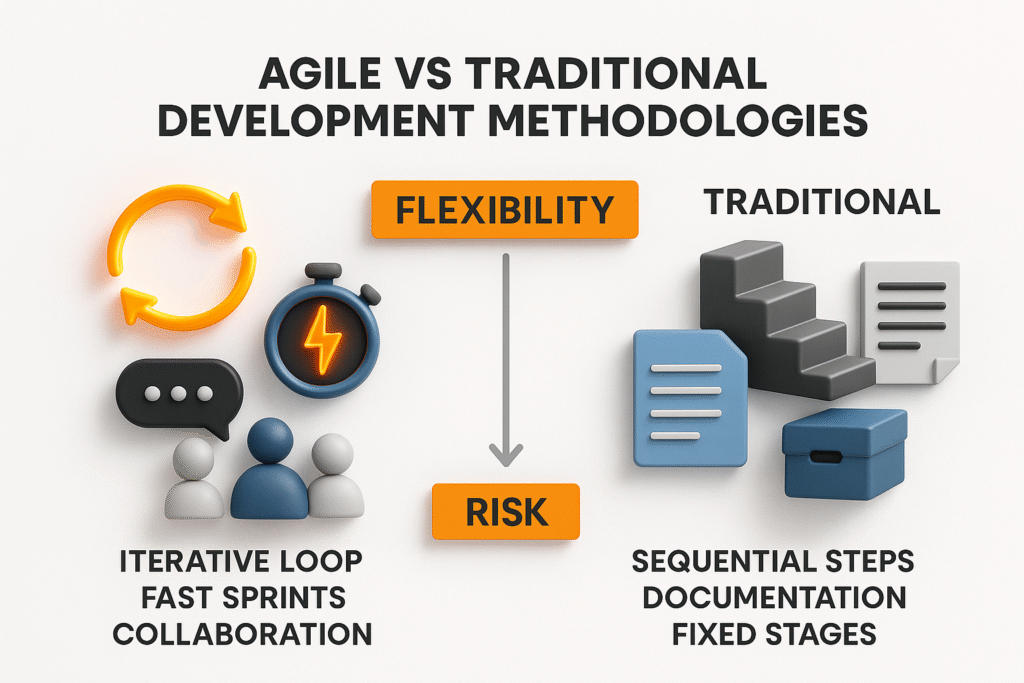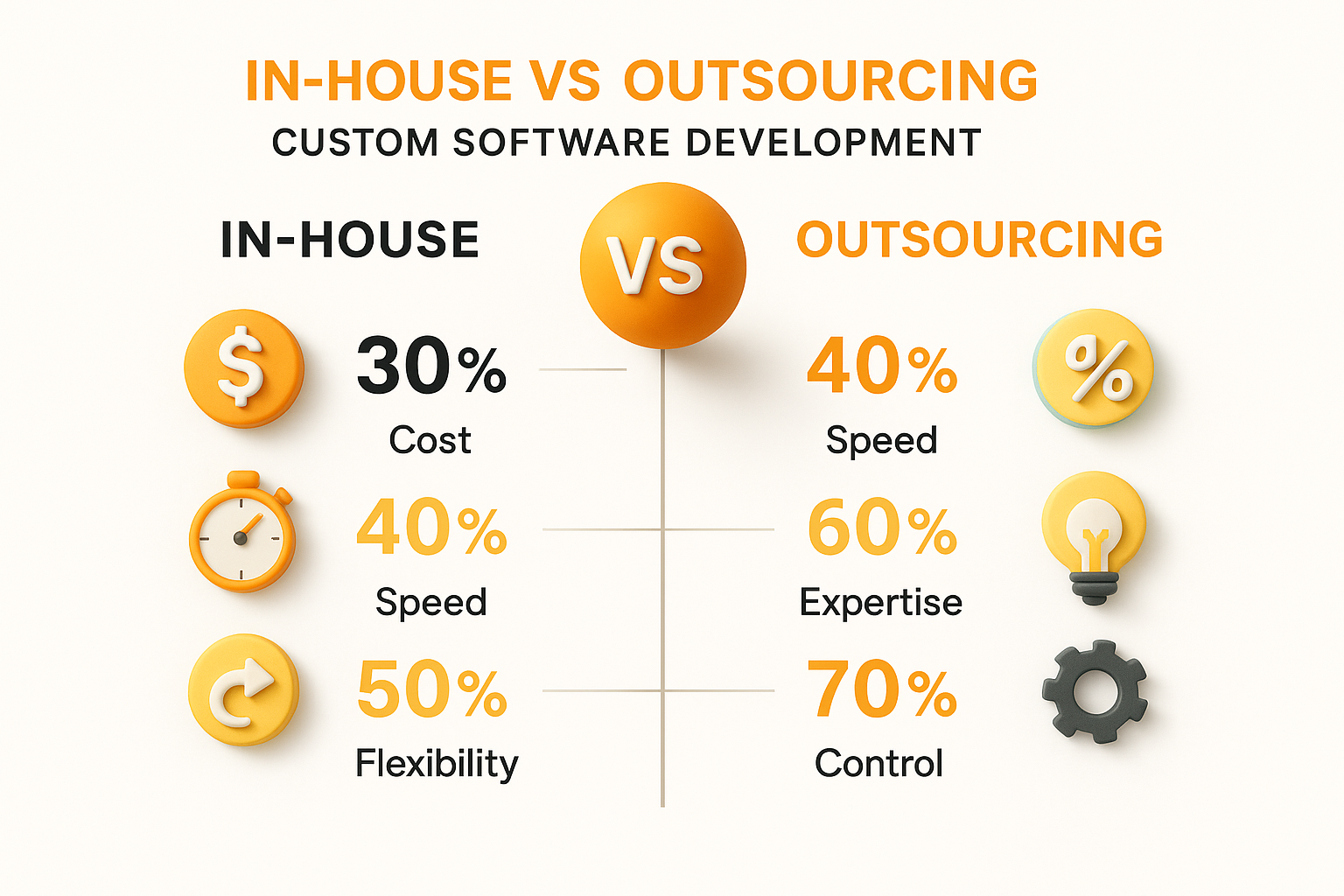Investing in custom software development is one of the smartest decisions your business can make, but only if you get it right. According to recent industry data, the global custom software development market is projected to reach $146.18 billion by 2030, growing at a CAGR of 22.5%. Yet many companies spend hundreds of thousands of dollars building tailored solutions, only to see minimal returns because they failed to plan strategically, chose the wrong development approach, or partnered with inexperienced teams.
The truth is, custom software development can deliver exceptional ROI when you follow proven strategies that align technology with your unique business goals. Research shows that top economic performers achieve higher returns by building proprietary software assets rather than relying solely on off-the-shelf solutions. Whether you’re a startup founder, CTO, or business owner, understanding how to maximize your investment in custom software development will help you reduce costs, boost efficiency, and unlock new revenue streams. In this guide, you’ll discover game-changing tips to ensure your custom software development delivers measurable results and long-term value for your business.

Why Custom Software Development is a Smart Investment
Custom software development offers tailored solutions designed specifically for your business needs, unlike off-the-shelf products that force you to adapt your processes to fit generic features. When you invest in custom software development services, you gain complete control over functionality, scalability, and integration capabilities.
1.The Core Benefits of Custom Solutions:
The custom software development benefits are clear and measurable:
-
Tailored functionality that eliminates unnecessary features bloating costs and slowing down your team
-
Complete ownership of your software without recurring licensing fees or vendor restrictions
-
Seamless integration with your existing systems and workflows
-
Competitive differentiation that sets you apart from competitors using generic tools
-
Enhanced security with protocols designed for your specific vulnerabilities and compliance requirements
According to software development statistics, enterprises investing in custom solutions experience over 10% year-over-year growth compared to those relying on commercial software.
2.Scalability and Long-Term Value:
Scalability is another critical advantage of custom software development. As your business grows, custom software grows with you, adapting to new challenges without requiring expensive replacements or complicated workarounds. You also avoid vendor lock-in, giving you freedom to innovate and pivot as market conditions change. Security is a major concern for modern businesses, and custom solutions provide enhanced protection compared to widely used commercial software that hackers frequently target. With custom development, you can implement advanced security protocols tailored to your specific requirements.
3.Set Clear and Measurable Goals from the Start:
Before writing a single line of code, you must define exactly what success looks like for your custom software development project. Vague objectives lead to scope creep, budget overruns, and software that fails to deliver value.
4.Identify Specific Business Problems:
Start by identifying the specific business problems your software will solve:
-
Are you struggling with manual data entry that wastes hours each day?
-
Do you need better real-time visibility into inventory levels?
-
Is your customer support team overwhelmed by repetitive inquiries?
-
Are you losing revenue due to inefficient processes?
Pin down the pain points with precision before moving forward with development.
5.Establish SMART Goals:
Next, establish SMART goals: Specific, Measurable, Achievable, Relevant, and Time-bound. For example:
| Vague Goal | SMART Goal |
|---|---|
| Improve efficiency | Reduce order processing time from 15 minutes to 5 minutes within 6 months of deployment |
| Better customer service | Increase customer satisfaction scores from 72% to 85% within 90 days |
| Save money | Eliminate $50,000 in annual SaaS subscription costs by replacing three separate tools |
This clarity ensures everyone on your team and your development partner understands the target.
6.Define Key Performance Indicators:
Define key performance indicators (KPIs) that will measure success. Common KPIs for custom software development ROI include:
-
Cost savings from automation and process optimization
-
Revenue increases from new features and capabilities
-
Time saved per employee across different departments
-
Error reduction percentages and quality improvements
-
Customer satisfaction scores and Net Promoter Score (NPS)
Track these metrics before development begins to establish your baseline for comparison.
7.Involve All Stakeholders:
Document your requirements thoroughly and involve stakeholders from different departments. Your sales team, operations staff, and customer service representatives all have valuable insights into what features will drive the most value. Getting their input early prevents costly changes later in the custom software development process.
Choose the Right Development Approach to Maximize Efficiency:
The methodology you choose for building your custom software significantly impacts both timeline and ROI. Agile custom software development has become the gold standard because it delivers working software faster and allows for continuous improvement based on real user feedback.
Agile vs Traditional Approaches
| Approach | Timeline | Flexibility | Risk Level | Best For |
|---|---|---|---|---|
| Agile Development | Iterative sprints (2-4 weeks) | High adaptability | Lower risk | Most custom software projects |
| Waterfall Development | Sequential phases | Low flexibility | Higher risk | Projects with fixed requirements |
| Hybrid Approach | Mixed methodology | Moderate flexibility | Moderate risk | Complex enterprise systems |
Unlike traditional waterfall approaches that require complete specifications upfront, agile development breaks your project into smaller sprints. Each sprint delivers functional features you can test and refine, reducing the risk of building something users don’t actually need.

Start with a Minimum Viable Product:
Start with a Minimum Viable Product (MVP) that includes only the core features essential for solving your primary business problem. This strategy gets your software into users’ hands faster, allowing you to gather real-world data and validate assumptions before investing in additional features.
Benefits of the MVP approach for custom software development:
-
Faster time to market and earlier revenue generation
-
Real user feedback before major feature investment
-
Reduced development costs by eliminating unnecessary features
-
Validation of core assumptions and business hypotheses
-
Ability to pivot based on actual usage data
Prioritize Features Strategically:
Prioritize features based on business impact, not technical complexity or personal preferences. Use a framework like MoSCoW to categorize features:
-
Must have: Critical features without which the software won’t work
-
Should have: Important features that add significant value
-
Could have: Nice-to-have features that enhance user experience
-
Won’t have: Features postponed to future releases
The features that directly contribute to your ROI goals should always take priority in your custom software development roadmap.
Build Quality Assurance Throughout:
Build in regular testing and quality assurance throughout development, not just at the end. Continuous testing catches bugs early when they’re cheaper and easier to fix. It also ensures your software performs reliably when you launch, avoiding the costly reputation damage and lost productivity that come with buggy releases.
Select the Right Development Partner for Your Project:
Your choice of development partner can make or break your custom software development investment. While building in-house gives you direct control, it requires hiring specialized talent, managing complex projects, and pulling your existing IT team away from daily operations.

In-House vs Outsourcing: Making the Right Choice
Outsourcing custom software development to an experienced team often delivers better ROI, especially for businesses without deep technical expertise. Professional development companies bring proven methodologies, diverse technical skills, and experience across multiple industries.
Key advantages of partnering with a custom software development company:
-
Access to specialized expertise across multiple technologies
-
Proven methodologies that reduce project risks
-
Faster development timelines with dedicated teams
-
Cost savings compared to hiring full-time staff
-
Experience solving similar business challenges
Evaluating Potential Partners:
When evaluating potential partners, look beyond the lowest bid. Focus on these critical factors:
-
Portfolio and case studies: Review similar projects they’ve completed successfully
-
Client testimonials: Verify their track record with actual customer references
-
Industry expertise: Ensure they understand your specific business challenges
-
Technical capabilities: Confirm expertise in required technologies and integrations
-
Communication practices: Assess their responsiveness and project management approach
-
Post-launch support: Understand their maintenance and update policies
The RSquare Technologies Advantage:
RSquare Technologies specializes in delivering custom software development solutions that drive measurable business results. Our experienced team follows agile methodologies and maintains transparent communication throughout development. Whether you need to hire dedicated developers or want a full-service development partner, we tailor our approach to your specific needs and budget. Learn more about making informed decisions with our comprehensive guide on build vs buy vs outsource decision framework.
Leverage Modern Technologies for Competitive Advantage:
The technology stack you choose for your custom software development directly impacts its performance, maintainability, and ability to scale. Modern frameworks and platforms offer powerful features that can dramatically reduce development time and costs while improving the end-user experience.
Strategic Technology Selection:
For Robust Web Applications:
-
Laravel development services offer elegant syntax and extensive tooling for complex workflows
-
Built-in security features and testing capabilities ensure reliable, secure software
-
Ideal for custom business applications requiring sophisticated data management
For High-Performance Applications:
-
Node.js developers can build solutions handling thousands of concurrent users
-
Perfect for real-time data processing and scalable applications
-
Particularly valuable for custom software requiring rapid scaling
For User Experience Excellence:
-
Responsive web design services ensure flawless performance across all devices
-
Critical for custom software adoption and user satisfaction
-
Reduces training time and improves productivity
Emerging Technologies for Enhanced ROI:
Consider integrating artificial intelligence and machine learning capabilities where they add genuine business value. AI-powered features like predictive analytics, intelligent automation, and personalized recommendations can significantly enhance your custom software development ROI by delivering insights and efficiencies impossible with traditional approaches. According to industry research, businesses integrating AI into their custom solutions see productivity increases of up to 40% compared to traditional software implementations.
Implement Comprehensive Analytics:
Implement analytics from day one to track how users interact with your software:
-
Monitor which features get used most frequently and drive the most value
-
Identify where users encounter friction or abandonment
-
Track which workflows contribute most to business objectives
-
Measure performance metrics like load times and error rates
-
Analyze user behavior patterns for optimization opportunities
Tools like Google Analytics, Mixpanel, and custom dashboards provide the insights you need to make informed optimization decisions for your custom software development investment.
Calculate ROI Regularly:
Calculate your ROI regularly using both quantitative and qualitative metrics. According to ROI calculation best practices, a good ROI for custom software projects ranges from 5% to 10% annually, with some industries achieving up to 35%.
Quantitative Metrics:
-
Revenue increases from new capabilities
-
Cost savings from automation and efficiency gains
-
Time saved per employee across departments
-
Reduction in errors and rework
-
Decreased reliance on expensive external tools
Qualitative Benefits:
-
Improved employee satisfaction and retention
-
Faster decision-making capabilities
-
Better customer experiences and loyalty
-
Enhanced brand perception and market positioning
-
Increased competitive differentiation
Continuous Improvement Cycle:
Don’t wait for problems to surface. Establish regular review cycles where you analyze performance data, user feedback, and business metrics. Use these insights to prioritize updates and new features that will deliver the highest additional ROI from your custom software development investment.
Consider your custom software a living asset that requires ongoing investment. Technology evolves, business needs change, and user expectations rise. Budget for continuous improvements, security updates, and feature enhancements to protect and grow your initial investment.
Avoid Common Pitfalls That Destroy ROI:
Many custom software development projects fail to deliver expected returns because of preventable mistakes. Learning from these common pitfalls helps you protect your investment and ensure success.
1.Scope Creep Management:
Scope creep is the number one killer of custom software ROI. It happens when stakeholders continuously request new features beyond the original plan, stretching timelines and budgets until the project collapses under its own weight.
Combat scope creep by:
-
Establishing a formal change request process with impact analysis
-
Rigorously evaluating each addition against core objectives
-
Setting clear boundaries and approval requirements for changes
-
Maintaining a prioritized feature backlog for future releases
-
Communicating the cost and timeline impact of all changes
2.Poor Requirement Analysis:
Poor requirement analysis leads to software that solves the wrong problems. Many businesses discover after launch that their custom software development solution doesn’t address their actual pain points because they never properly documented and validated requirements with end users.
Prevent this by investing time upfront in:
-
Thorough discovery sessions with all stakeholder groups
-
User research and workflow analysis
-
Detailed requirement documentation and validation
-
Prototyping and mockups for early feedback
-
Regular requirement reviews and refinements
3.Inadequate Testing and Documentation:
Inadequate testing creates technical debt that haunts you for years. Rushing to launch without comprehensive testing leads to bugs, security vulnerabilities, and performance issues that damage user trust and require expensive emergency fixes.
Build quality assurance into every stage of custom software development:
-
Unit testing for individual components
-
Integration testing for system interactions
-
User acceptance testing with actual users
-
Performance and load testing for scalability
-
Security testing and vulnerability assessments
Neglecting documentation makes maintenance difficult and expensive. When the original developers move on and your team needs to update or fix something, poor documentation turns simple changes into major research projects. Require comprehensive documentation as a deliverable.
4.Scalability Planning:
Failing to plan for scalability costs you later when success strains your system. Build your custom software development project with growth in mind, following the principles outlined in our guide on how to build scalable web applications. Planning for scale from the start costs far less than rebuilding later.
Partner with RSquare Technologies for Maximum ROI:
Getting custom software development right requires expertise, experience, and a partner who understands both technology and business. At RSquare Technologies, we specialize in delivering custom solutions that drive measurable results for startups, tech founders, and growing businesses.
Our Proven Approach:
Our team follows proven methodologies that maximize ROI at every stage of custom software development:
-
Deep discovery: We start by thoroughly understanding your business challenges and objectives
-
Strategic planning: We design solutions that address your specific needs without unnecessary complexity
-
Agile execution: Our iterative approach ensures you see working software quickly and can provide feedback
-
Quality assurance: We build testing and optimization into every development sprint
-
Ongoing support: We provide maintenance, updates, and enhancements to protect your investment
Comprehensive Service Offerings:
Whether you need custom web application development, e-commerce solutions, or specialized business software, we have the expertise to bring your vision to life. Our developers stay current with the latest technologies and best practices, ensuring your custom software development project is built on a solid, future-proof foundation.
Your Success is Our Priority:
We believe in transparency and collaboration. Throughout your custom software development project, you’ll receive regular updates, clear communication, and direct access to our development team. We’re not just building software, we’re building a partnership focused on your long-term success. Ready to maximize your ROI with custom software that truly fits your business? Contact us today to discuss your project and discover how RSquare Technologies can help you achieve your goals. You can also explore our services to see the full range of solutions we offer.
For additional insights on optimizing your development strategy, read our articles on outsourcing software development for startups and IT staff augmentation strategies.



